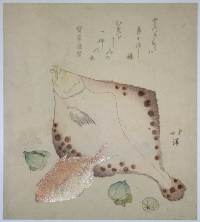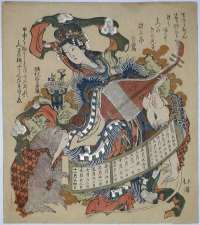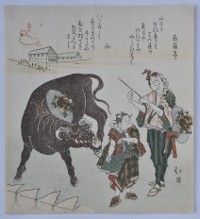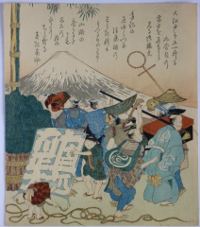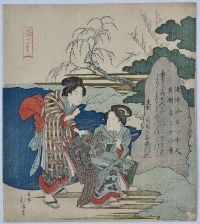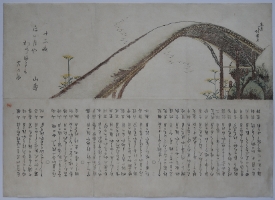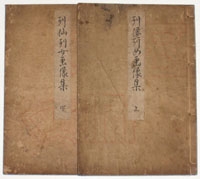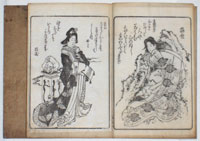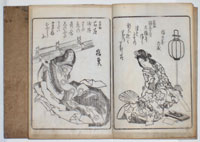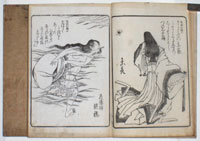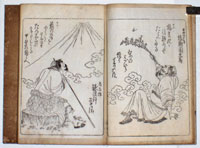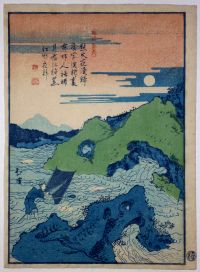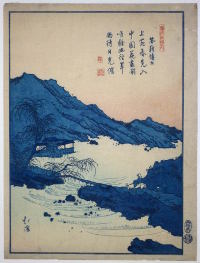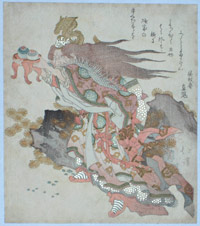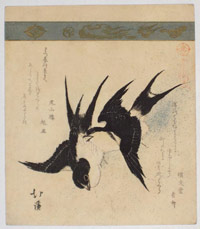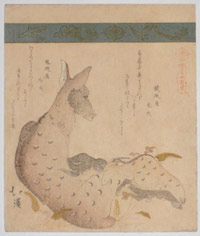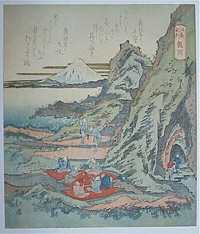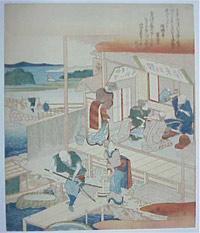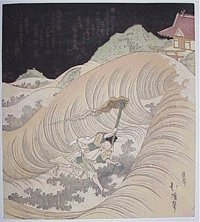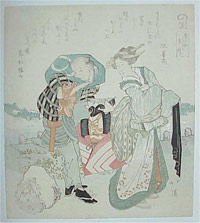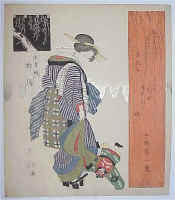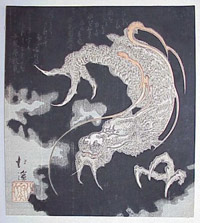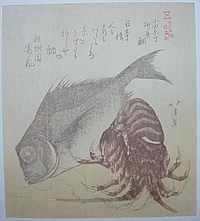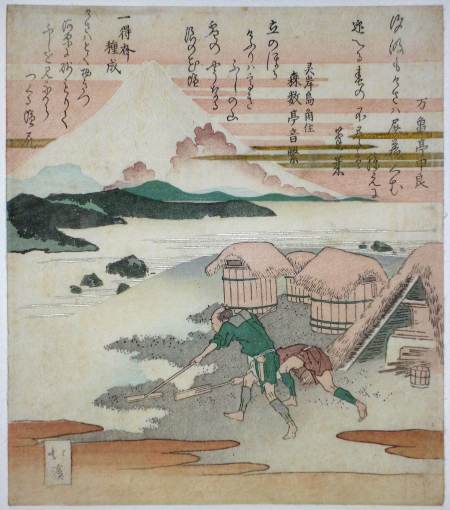Totoya HOKKEI (1780-1850)

Click here to view image full size.
An original painting, full colour with gold outline to robe, 32 x 10.75 in; 81.3 x 27.3 cms, on silk. Shows a beauty erotically biting on her hand towel (tenugui) while on the way to a public bath house. This gesture represented deep emotion. Hokkei was one of Hokusai’s earliest and best pupils who not only produced paintings but illustrated books and is especially known for his fine surimono. Illustrated in Nihon ukiyoe hakubutsukan, ed., Nikuhitsu ukiyoe senshu gekan (Selected Painting of Ukiyo-e, second vol.) (Tokyo: Gakushu kenkyusha , 1985). Plate 188. In very good condition with an interesting shibori (tie-dyed) mount, cleverly echoing the pattern on the material she holds. Signed Hokkei ga with Hokkei seal.
Status: Available
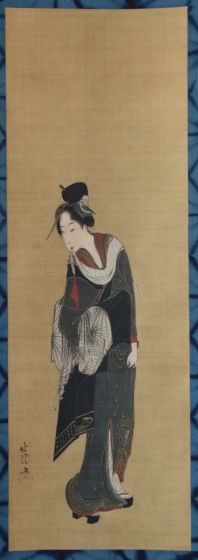
Click here to view image full size.
Totoya HOKKEI (1780-1850)
Click here to view image full size.
A still life surimono showing a right-eye flounder or flatfish, Karei, and a red bream, kaneme-tai. And small unidentified vegetables. Provenance: A slip from a catalogue on the back indicates that it comes from a Paris sale, probably early 20th century describing it as Limande et dorade. Hokkei is best known for his surimono. He was originally a fishmonger, hence his name Totoya, and also accounts for the number of surimono he designed with fish and shells. Extremely rare.
Fine impression and colour with mica on the bream. Minor soil, otherwise very good condition. Signed Hokkei.
Status: Sold
Totoya HOKKEI (1780-1850)
Click here to view image full size.
A surimono showing the Japanese Buddhist goddess Benten, as always with her lute, and a monkey and rat holding a scroll showing the short months (2,4,7,9,12) for the Rat year, 1828. Benten (Hindu: Saraswati) originates from India via China. She is also one of the Seven Gods of Good Fortune. A fukujuso plant in a pot to her right. Poems by Ganjotei Shirataka and Tetsujoan Maori.
Very fine impression with extensive silver and gold. Signs of mounting au verso, otherwise very good condition. Fine colour. Signed Hokkei.
Status: Sold
Totoya HOKKEI (1780-1850)
Click here to view image full size.
Hokkei, a pupil of Hokusai, is best known for his fine surimono. This rather enigmatic example shows an ox being led by a farmer and his son. There appears to be a festival element in the headgear. Presumably issued for the Ox year (1829). The poetry club logo, top left, is in the form of an ox. Another impression is in Harvard, 1933.4.1981, and another example is in the MFA, Boston, 11.20608. Interestingly, this example lacks the aforementioned ox seal: Possibly there was a commercial printing of the surimono.Two poems above. Rare.
Fine impression. Fine colour with extensive silver. Fine condition. Signed Hokkei.
Status: Sold
Totoya HOKKEI (1780-1850) (Attrib. to.)
Click here to view image full size.
A surimono showing a new year’s throng of musicians, a monkey trainer, a samurai and children with a large kite. Possibly one sheet of a diptych or triptych. A beautiful example of the art of the surimono. Rare.
Superb impression. Fine colour with extensive silver, gold and blind-printing.
Status: Sold
Totoya HOKKEI (1780-1850)
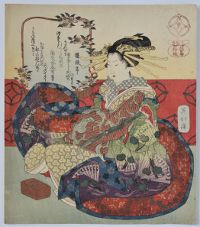
Click here to view image full size.
Originally a fishmonger (hence the go Totoya). Studied painting under Kano Yosen’in and then became one of Hokusai’s best pupils. Produced excellent surimono such as here showing a sumptuously attired courtesan representing Kyoto from a set of three surimono Sangoku-shi no toen ketsugi, a History of the Three Kingdoms. (A play on the Chinese states of Wei, Shu and Wu during AD 220-280, but here being Kyoto, Edo, Osaka.) Produced for the Shipporen (“Seven Treasures”) Kyoka Club c 1827. Their emblem top right and also incorporated into the background and on the box bottom left. Extremely rare.
Superb impression, colour and condition with extensive silver and gold. One of the finest surimono I have catalogued. Signed Go Hokkei.
Status: Sold
Totoya HOKKEI (1780-1850)
Click here to view image full size.
A surimono showing two beauties by the pond at Tsunowazu Kumano Shrine in Yotsuya. The title is: Yotsuya Juniso, referring to the twelve shrines at Tsunowazu in Yotsuya. The poem on the large stone is by Shibanoya and refers to the peacefulness of the place with the willows and water. The other writing directs visitors to the cool of the nearby waterfall and the Unju forrest.
Fine impression with silver and gold. Fine colour and condition. Signed on request, Motome ni ojite Hokkei fude.
Status: Sold
Totoya HOKKEI (1780-1850)
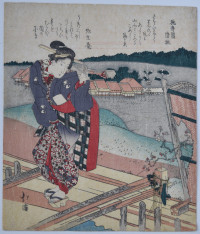
Click here to view image full size.
A surimono showing the poetess Kiyogaki standing on Mukaigaoka Hill overlooking a frozen Shinobazu Pond with the shrine of Benten. (And since the snake was the messenger of Benten, this print was probably issued for Snake Year 1833.) Two poems by Tojuen Kiyogaki and Yayoian.
Fine impression and colour with extensive silver – especially on the frozen lake. Slight soil, otherwise very good condition. Signed Hokkei.
Status: Sold
Totoya HOKKEI (1780-1850)
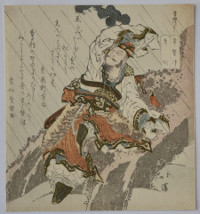
Click here to view image full size.
A surimono from a set Onkyoku zukushi, “An Array of Songs.” In the cartouche, top right, on the right, is Tokiwazu (a school of vocal music featuring the 3-stringed shamisen), and on the left the title of the musical piece illustrated here, which is Oimatsu, “Old Pine Tree,” a brief and auspicious piece composed in 1747 and used for celebratory occasions. A warrior is shown reclining against an old pine in heavy rain. Issued c 1818. Another from the set is illustrated in Reading Surimono, John Carpenter, Hotei publishing, 2008, no. 76, p. 203. Rare.
Fine impression with gold, blind-printing and the rain printed in silver. Very good colour. The red may be down slightly but, as yet, I have not found another impression to compare. Very good condition. Signed Hokkei.
Status: Sold
Totoya HOKKEI (1780-1850)
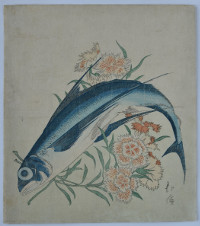
Click here to view image full size.
A surimono showing an unidentified fish – possibly a flying fish and carnations. An apparently unrecorded surimono. A pupil of Hokusai, Hokkei’s oeuvre was almost entirely in this genre, apart from illustrating ehon.
Very good impression and colour. Slight crease, otherwise very good condition. Signed Hokkei.
Status: Sold
Totoya HOKKEI (1780-1850)
Click here to view image full size.
An uncut large surimono with the poems attached showing a rustic bridge in a country setting. Geese flying above. Published c 1810s. Provenance: Ex Samuel Tuke collection, seal centre left. Tuke was a member of the Japan Society of London and many of his prints went to the British Museum, while others were sold at Sothebys in 1911. Rare.
Very good impression, colour and condition. Signed Totoya Hokkei ga.
Status: Sold
Totoya HOKKEI (1780-1850)
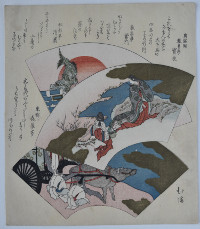
Click here to view image full size.
A surimono showing three overlapping fans. The top fan shows the first sunrise of the new year behind a shachi on a castle roof. Usually called dolphins, they in fact had the head of a tiger and body of a carp. The second shows a court lady and attendant collecting young pines on the first day of the year. The third shows an imperial ox cart. Possibly for the Ox year 1829. Another impression was in the Adolphe Stoclet sale, Sothebys 8th June 2004, lot 463, p. 242. Poems by Shinshukei, Shigekado and Shinratei Manzo (leader of the Manjiren club).
Very fine impression and colour with gold and silver. Fine condition. Signed Hokkei.
Status: Sold
Yashima GAKUTEI (1786-1868) and Totoya HOKKEI (1780-1850)
Click here to view image full size.
Two vols. kyoka books complete: Ressen retsujo gazoshu, a “Collection of the Portraits of Immortal Men and Women.” Twenty eight portraits of Chinese hermits and twenty one portraits of celebrated women in Japanese history. Being a selection of kyoka presented at the meetimg held at Kawachiya of Yanagibashi Ryogoku in Edo, 1st day of the 9th month, Bunsei 7 ( 1824 ). Published by Shinsenyen. Rare.
Original covers and title slips. Minor marks to covers, otherwise very good condition.
Status: Sold
Totoya HOKKEI (1780-1850)
Click here to view image full size.
A fisherman with a scoop and net seemingly trying to catch the moon’s reflection. One of an excessively rare chuban series with title Toshi gafu no uchi, “Drawing Album for Chinese Poems” printed in red, and sub-title Toshin denshi. Printed in tones of blue except for a light flush on the horizon. Another impression ( trimmed ) was in the Vever collection ( ex Hayashi ), Sotheby’s, Part III, lot 295. Other impressions ( damaged ) are in the BM, ref: 1937, 0710,0,230 and Honolulu Museum of Art, ref: 14463. Hokkei was one of Hokusai’s best pupils and designed many fine surimono.
Fine impression, colour and condition. Signed Hokkei.
Status: Sold
Totoya HOKKEI ( 1780-1850 )
Click here to view image full size.
A mounted sage followed by his servant crossing a bridge over a lake. One of an excessively rare chuban series with title Toshi gafu no uchi, “Drawing Album for Chinese Poems” printed in red, and sub-title Toshin denshi. Printed in tones of blue except for a light flush on the horizon. Another impression ( trimmed ) was in the Vever collection ( ex Hayashi ), Sotheby’s, Part III, lot 295. Other impressions ( damaged ) are in the BM, ref: 1937, 0710,0,229 and Honolulu Museum of Art, ref: 14466. Hokkei was one of Hokusai’s best pupils and designed many fine surimono. Unidentified publisher’s seal and censor’s seal in right margin ( trimmed off on the other impressions ).
Fine impression and colour. Very good condition. Signed Hokkei.
Status: Sold
Totoya HOKKEI (1780 – 1850)
Click here to view image full size.
The Dragon King, Ryu-jin, presenting the tide-ruling jewels Nanjiu and Kanjiu. In Japanese folklore he ruled the sea and inhabited a spectacular castle in the depths of the ocean.
Fine impression and colour with extensive gold and silver. Minimal edge soil. Signed Hokkei.
Status: Sold
Totoya HOKKEI (1780-1850)
Click here to view image full size.
Two swallows diving above a stream from a set Sanju-roku tori zukushi, “A Series of Thirty-six Birds and Animals”. The title in the shape of a rolled makimono top right. A takaramono printed in gold on blue with good luck symbols runs along the top. Produced for the Shipporen Poetry Club c1830. Poems by Fukubunro Arimasu and Kozanro Okikaze. Of the utmost rarity: Surimono, when encountered from this series, are invariably reprints or copies. Only known as a Meiji Akashi reprint. Others from the set are illustrated in: Vever I, 1974, lot 339; Gale Catalogued, Hillier 1970, no 253; Le Veel sale ( 3rd Part ) 1981, lot 165.
Fine impression and colour with sprayed blue pigment to simulate water drops. Very small repaired wormhole at bottom, otherwise very good condition. Signed Hokkei.
Status: Sold
Totoya HOKKEI (1780-1850)
Click here to view image full size.
A deer with her fawn from a set Sanju-roku tori zukushi, “A Series of Thirty-six Birds and Animals”. The title in the shape of a rolled makimono top right. A takaramono printed in gold on blue with good luck symbols runs along the top. Produced for the Shipporen Poetry Club c1830. Poems by Fukukitei Karakusa and Eigado Soya. Of the utmost rarity: Surimono, when encountered from this series, are invariably reprints or copies. The only impression I have catalogued of this design. Others from the set are illustrated in: Vever I, 1974, lot 339; Gale Catalogued, Hillier 1970, no 253; Le Veel sale ( 3rd Part ) 1981, lot 165.
Fine impression and colour. Light pink ground. Minimal marks, otherwise very good condition. Signed Hokkei.
Status: Sold
Totoya HOKKEI (1780-1850)
Click here to view image full size.
A rare surimono with title: Enoshima kiko, Ryudo, “Record of a Journey to Enoshima”. A set of sixteen prints for the Manji-ren Club ( their swastika seal top right above title cartouche ). Each surimono has an association with Enoshima, as here, where the year of issue is 1833, a Snake Year, the reptile being the messenger of Benten whose shrine is situated at Enoshima. The scene shows a picnic party enjoying the view, while a couple explore the Dragon’s Cave on the right. In the distance the snows of Mount Fuji stand out in silver. Two other impressions illustrated in One Hundred Surimono in the Collection of Sidney C. Ward, no.28, p.35 and the second Le Veel sale. 1980, lot 149.
Very fine impression, colour and condition with silver, gold and gauffrage. Signed Hokkei.
Status: Sold
Totoya HOKKEI (1780-1850)
Click here to view image full size.
A rare surimono showing a tea-house on an inlet. A couple are being entertained by a waitress in an open room while another goes to collect fish from a man holding a fish-scoop. The shop sign indicates a magnificent view of Kanto ( the provinces situated east of the Hakone Barrier Station ).
Very fine impression, colour and condition. Extensive details in gold and silver. Signed Hokkei.
Status: Sold
Totoya HOKKEI (1780-1850)
Click here to view image full size.
Shows a Shinto priest carrying a firebrand and running to avoid a large wave. In his left hand he carries me, an edible seaweed which he has gathered. This ritual was carried out at night on New Year’s Eve at the Hayatomo Myojin Shrine, in northern Kyushu. The shrine is seen, top right, beneath a black sky. Other examples of this rare surimono are illustrated in: Vever sale, Part 1, Sothebys, 1974, lot 336, p.315; Jewels of Japanese Printmaking: Surimono of the Bunka-Bunsei era 1804-1830, Joan B. Mirviss, 2000, no.48, p.97 ( colour ); One Hundred Surimono in the Collection of Sidney C. Ward, no.26, p.32; Surimono, Steff Schmidt and Setsuko Kuwabara, 1990, no.38, p.92. One of the finest surimono designs. Published c early 1830s.
Fine impression. The red of the firebrand turned, otherwise very good colour. Extensive flecked foam printed silver and the gold of the poems, against the black sky, intact. Very good condition. Signed Oju Hokkei hitsu.
Status: Sold
Totoya HOKKEI (1780 – 1850)
Click here to view image full size.
A surimono showing a courtesan with attendant holding a kite with an image of Danjuro in a shibaraku role. Title: Haru no machi, “The Series of Spring Town”. Issued by the Fundarikaren Club. Their emblem is repeated on the cloth sack the attendant carries on his back. Rare: This is the only genuine impression I have catalogued.
Fine impression and colour with gold and silver. Slight fading, otherwise fine condition. Signed Hokkei.
Status: Sold
Totoya HOKKEI (1780-1850)
Click here to view image full size.
A young beauty holding a fallen kite from a series: Yanagi bantsuzuki “A Series of Willows”, sub-title: Yanagi yu “The Public Bath Willow”.
Fine impression and colour. Slight signs of mounting au verso, otherwise good condition. Signed Go Hokkei.
Status: Sold
Totoya HOKKEI (1780-1850)
Click here to view image full size.
A dragon emerging from dark clouds. An extremely rare surimono; the few other known examples being trimmed.
Fine impression, very good colour and condition. Signed Hokkei.
Status: Sold
Totoya HOKKEI (1780-1850)
Click here to view image full size.
A langoustine and fish. An extremely rare surimono designed for the Gogawa Club (seal top right) and produced by Shunman sei.
Very good impression, colour and condition with blind-printing on fish. Signed Hokkei sha.
Status: Sold
Totoya HOKKEI (1780-1850)
Click here to view image full size.
An exceptionally rare surimono showing salt gatherers on a beach, their huts behind them and Mount Fuji towering over the horizon. Published c 1820s. I cannot, at the moment, locate another impression.
Fine impression with gold clouds and Fuji heavily blind-printed. Fine colour. Minimal soil, otherwise very good condition. Si8ned Hokkei.
Status: Sold
